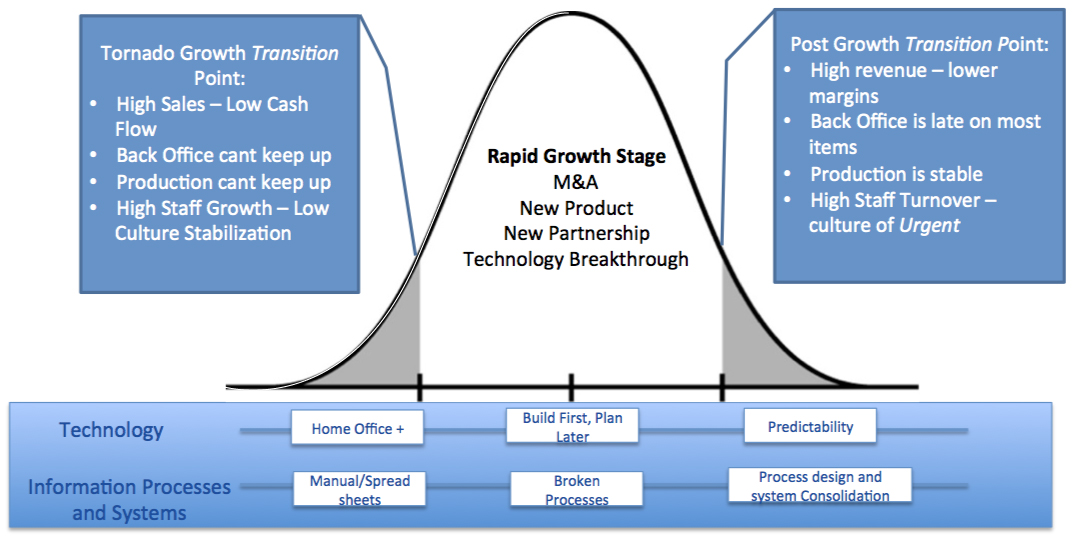Thinking in terms of cycles is a way human beings make sense out of life. Cycle Theory can be applied to just about every natural, social and historical concept there is, from world power cycles to international relations cycles to sociological and psychological cycles. What all these cycles have in common is that they form a circle that goes around and around, carried forward by a natural, ceaseless momentum – and they’re not easy to change.
I’ve used cycle theory to make sense out of individual business’s growth cycles – what I call the Business Storm Cycle. The Business Storm Cycle is divided into these phases and transition points:
- The entrepreneurial or startup phase
- The acceleration transition point that begins a Tornado – that longed-for yet terrifying period of accelerated, out-of-control sales and growth
- The deceleration transition point that leads to an Avalanche – the feared yet inevitable point at which your business’s margins are shrinking while your costs are accelerating.
- The consolidation phase
All businesses, if they get past the startup phase, will experience these phases again and again – but a lot of them won’t make it past that critical liftoff. Why do so many businesses run into trouble during the startup phase? Often, it’s because the startup tries to run before it can walk. IT is essential to every department these days, and yet if it’s not properly integrated with people and processes, the very thing that’s intended to increase a business’s production and efficiency can be what’s getting in its way. Every single aspect of the back office depends on IT—accounting, invoicing, banking, finance, investor relations, communications, legal, human resources—which means that IT is the back office’s backbone. But a backbone can’t do its job if the rest of the skeleton isn’t properly connected to it; and if people and processes aren’t integrated with IT, you’re setting yourself up for trouble later on in the Business Storm Cycle.
That’s what happened to MedicaLogic, a West Coast company where I was program manager back in the 1990s. MedicaLogic had a product called Logician, which was an electronic medical record (EMR) that we’d developed about fifteen years before the world really wanted one. MedicaLogic was insistent, however, that Logician was going to make them the leader in a new market as it unfolded. Unfortunately for them, the rules for EMRs weren’t published until 2011, which was ‘way too late for this company.
We didn’t know we’d entered the game too early, though; we had a product, we were implementing it, and we were making sales. The company kept my team and me busy for five years with Logician. We went from one health-care system to the next, implementing and adapting the system to meet their needs. MedicaLogic’s growth was accelerating, and venture capital was flowing. Before long, the company had even gotten out of the red and into the black. It was making real money. This company was actively preparing for a Tornado they hoped was on its way. In the process, they were making fatal mistakes.
All their technology was built around the EMR, while there was no technology in the rest of the building. It was so bad that if we needed a router or a switch, we’d run down to the local electronics store to pick one up and then install it ourselves. If someone needed a new phone, she went to the closest phone store and bought one with her own money. In fact, one night when I was at corporate, I took a rental car to Portland to buy a compact disc replicator because we didn’t have one—and we needed to produce a case of demo and marketing CDs for a trade show. Our technology in the rest of the company was a pieced-together, make-do structure that was just enough to get the company’s new software out the door. People and processes were in just as bad shape. Too many people wore too many different hats. The ratio of support staff to the operations and development staff was unmanageable. There was simply too much work with too few people, as well as too few processes. The processes that did exist didn’t have the technology they needed to support them. All this became the sword on which this company fell.
People, processes, and IT will all have different needs at each of the different phases of the Business Storm Cycle. That’s why it’s so important to make them scalable, so you can adapt to whatever phase your business is in. Then you won’t have to start from scratch every time you enter a new stage in your life as a business. By changing your approach from fixing symptoms to defining your problems and solving them, you will create solutions that will help you survive today’s problems, as well as those you’ll face when you reach the next phase of the Business Storm Cycle.

